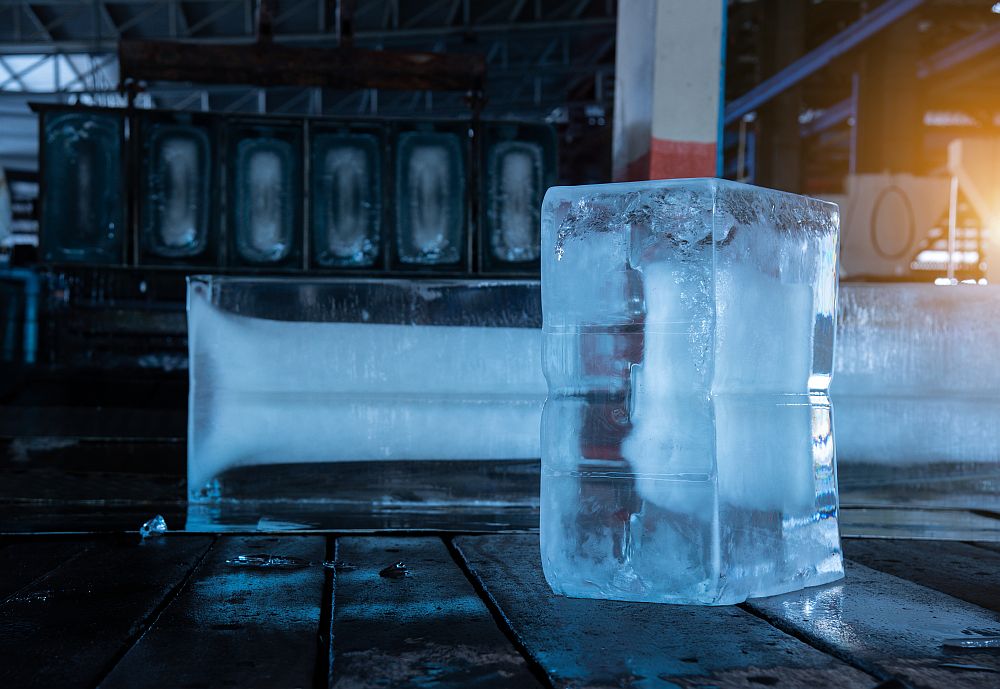
[Image above] Example of an ice factory. Ice-based cooling systems are gaining renewed interest as a more sustainable approach to thermal regulation. Credit: APChanel / Shutterstock
Fire and ice: These two natural forces are often contrasted in terms of their destructive potential, but both have also played crucial roles in the development of civilization. But while the former leaves behind evidence of its impact through sediment changes and burned remnants, the latter melts into an elusive trail, making its uses more difficult to decipher.
In today’s CTT, we are diving into the history of ice-based cooling systems and how concerns about the environment have revived interest in this technology.
Historically ‘cooler’ than you would think
For many people living in the U.S., ice is a staple food in their freezer, ready to cool household beverages at a moment’s notice. But it is only recently we developed the technology to create ice on command, which means previously it had to be procured through natural sources.
Dating back to at least the early second millennium BCE, ancient civilizations would harvest ice from the mountains and store it underground so it could be used later for food preservation, water cooling, and medical purposes. Because of this reliance on natural sources, ice was considered a luxury item, with its primary use being to cool drinks or make frozen desserts for the elite.
As the development of ice storage facilities advanced, the practice of using ice for food-related purposes started to expand beyond the nobility in places such as Italy and France, where it was used in early recipes for flavored ices and sorbets.
In the United States, ice was primarily harvested from frozen ponds and lakes, with many of the same personal uses. The advent of the 19th century ice trade saw significant developments in ice storage capabilities alongside increased demands from the growing immigrant populations between 1850–1890.
During this time, some ambitious minds started imagining uses for ice on larger scales beyond food purposes and began harnessing it to cool buildings, also known as “comfort cooling.”
One of the earliest examples of this concept was published in 1864, when George Knight of Cincinnati proposed a cooling system for hospitals in Scientific American. This system, which was ideally meant to be used in the hot summer months, involved a ventilating system and an air washer, which is an air purifier that uses water to trap pollutants and ensures clean air flow.
The water for the air washer would run through a coil that was immersed in melting ice, making it cooler. Then the warm air from the outside would be pushed through the cold-water spray by a fan and distributed through perforated outlets, providing cooler air for the patients inside.
Although some other methods for ice-based comfort cooling were explored in the late 19th century, the challenge of fog formation with simple ice-based systems meant that mechanical refrigeration took precedence for this application.
Air’s capacity to hold moisture decreases at lower temperatures. If cold air is pushed into a room with high humidity, the cooler air cannot hold all the moisture any longer, leading the excess water vapor to condense and deposit moisture on the walls.
Early ice-based comfort cooling systems primarily focused on cooling the air to a desired temperature without implementing processes to combat humidity. In contrast, mechanical refrigeration involves the conversion of a chemical refrigerant from gas to liquid to back again, and it includes components, such as evaporator coils, to achieve more precise control of humidity.
While ice-based cooling systems can make use of humidity controls as well, development of mechanical refrigeration systems advanced more quickly. By the turn of the century, the natural ice trade fell into decline as artificial ice and mechanical refrigeration systems became more mainstream. Specifically, the year 1902 welcomed what many claim to be the first modern air conditioning system by Willis Carrier, who wanted to prevent humidity from affecting the quality of paper at a printing press.
The years leading up to the World Wars saw an increase in comfort cooling systems in buildings such as hotels, offices, theaters, restaurants, stores, and hospitals. Most of these systems relied on mechanical refrigeration rather than ice-based cooling for the reasons stated above.
In the 1930s, a group from General Motors synthesized chlorofluorocarbon coolants, the first nonflammable refrigerating fluids. These chemicals became the mainstream agent used in refrigeration, and by the mid-20th century, mechanical refrigeration had not only eclipsed ice-based comfort cooling systems but also replaced ice boxes for food preservation.
Several events in the 1970s cast a critical look at mechanical refrigeration systems, however. For one, scientists started to realize the link between chlorofluorocarbon coolants and ozone degradation, and global production of these chemicals was phased out by 2010. Hydrofluorocarbons emerged as the next generation of refrigerants, but these chemicals have negative environmental effects, too, so they are in the process of being phased out.
The 1970s also went through an energy crisis, which led to the passage of specific laws to reduce energy consumption. In particular, the Appliance Equipment Energy Standard Program mandates a federal energy efficiency standard for all air conditioner manufacturers.
Based on these environmental and energy-related concerns, ice-based cooling systems are starting to see a revival as a more sustainable approach to temperature regulation.
The 21st century’s renewed interest in ice-based comfort cooling
In recent years, there has been renewed interest in using ice-based thermal energy systems as a sustainable option to cool a building without relying on as much electricity (or chemicals) as mechanical refrigeration.
Thermal energy storage (TES) refers to systems in which energy is stored in a material for later use. TES can be traced back to 1803, with Thomas Moore’s invention of the icebox to prevent butter from melting.
The way that ice-based TES systems work is relatively simple: During the night, when there is less demand on the electricity grid and therefore electricity is cheaper, water is frozen into ice; as the ice thaws throughout the next day, it cools the water that circulates through the pipes of the building, and cooler air is distributed as a result.
As explained in an Associated Press news article, Norton Audubon Hospital in Louisville, Ky., freezes around 74,000 gallons of water each night in lieu of a traditional air conditioning system. They have saved an estimated $4 million in electricity costs since they first implemented the system in 2016. The article notes that manufacturers of ice-based cooling systems have reported an increased demand for their systems as well.
The need for more sustainable temperature regulation systems is even more urgent with the significant growth of data centers over the past few decades. Data centers require a controlled climate to prevent information technology equipment from overheating, which means more electricity (and subsequent carbon emissions).
In the past, water has been used in data centers as a way to absorb heat coming off of the equipment, subsequently cooling the surrounding air. However, the complexities of both the water-cooling systems and data center equipment can lead to inconsistencies and significant energy use.
This situation creates a demand for more energy-efficient cooling systems, especially with the rapid rise of artificial intelligence. Ice-based TES systems may prove to be a solution for manufacturers looking to keep their buildings cool and energy costs low.
The evolution of ice applications has come a long way, and it may once again prove to be a “cooler” option for keeping people and buildings comfortable while also reducing harm to the environment.
Author
Helen Widman
CTT Categories
- Education
- Thermal management


